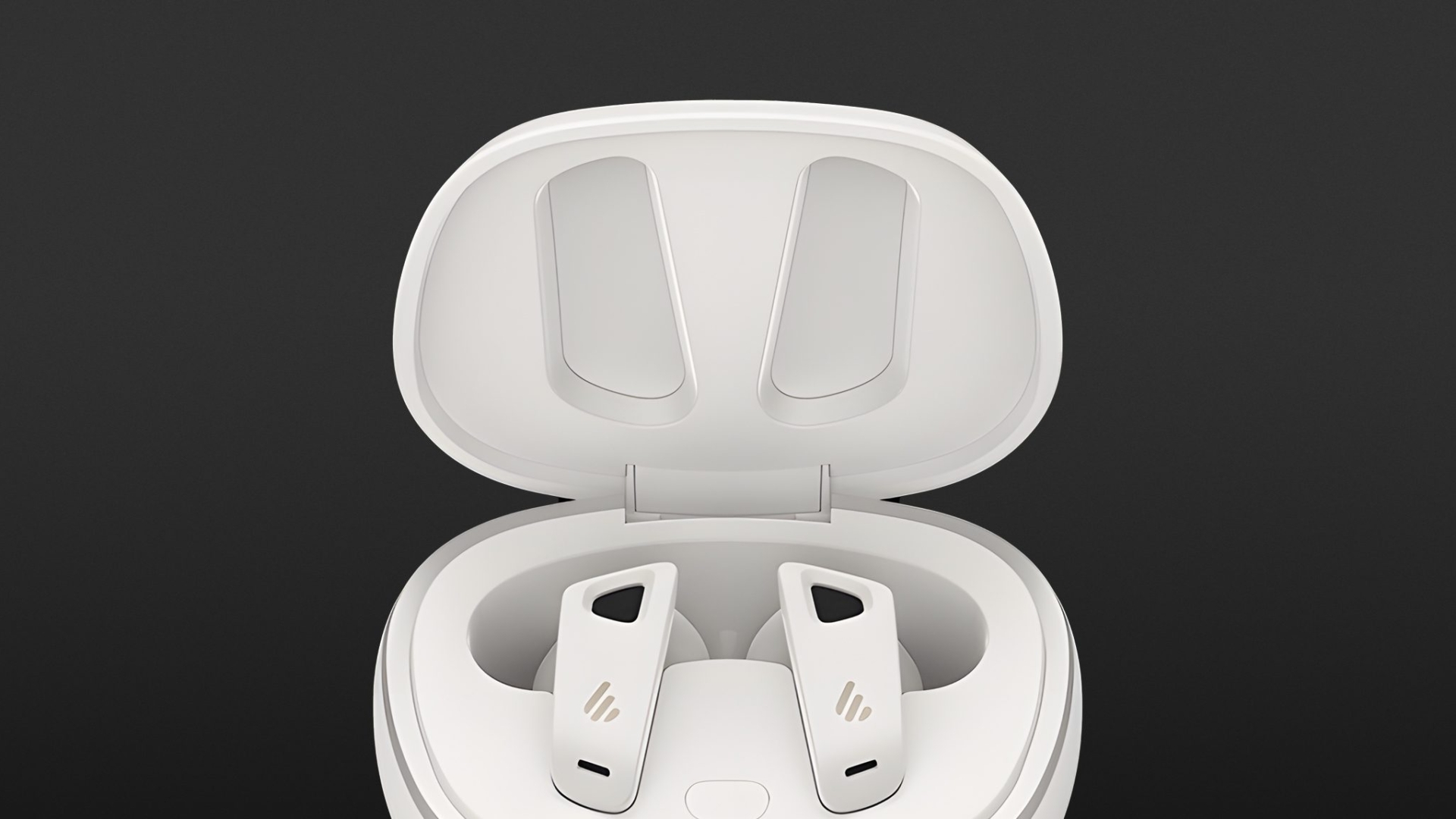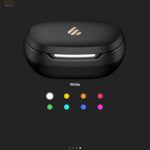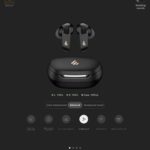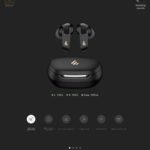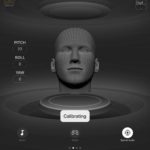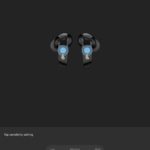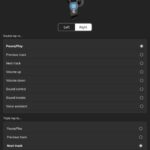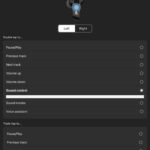The Edifier NeoBuds Pro 2 have a wealth of features, ranging from multi-channel noise cancellation, hybrid driver technology and premium audio codecs to functions such as spatial audio. Eight microphones with ENC (Environmental Noise Cancellation) technology are also designed to ensure clear voice transmission when making phone calls.
- Comfortable fit
- Fast charging function
- Multi-channel noise cancellation
- 3 transparency modes
- App connection with earpiece and sound customisation
- Extended frequency response (20 Hz to 40 kHz)
- Support AAC, LDAC and LHDC 5.0
- No multipoint connections
- Limited touch control
- No manual on/off switching of the in-ears possible
The Edifier NeoBuds Pro 2, which are available in black and ivory, come with a generous selection of ear tips in seven different sizes which allow these in-ears to be customised. Although these IP54 dust and splash-proof earphones protrude beyond the ear cups and are therefore not necessarily compatible with wearing hats, they fit comfortably and remain securely in the ears even during sporting activities.
Comparison: NeoBuds Pro and NeoBuds Pro 2
New features of the NeoBuds Pro 2 include spatial audio and wearer recognition, and these can be activated or deactivated as desired via the app. The noise cancellation has been significantly upgraded compared to the previous model, and it now works in multiple channels.
While the NeoBuds Pro, which supported LDAC and LHDC 2.0, relied exclusively on high-resolution audio codecs, version 2 supports a broader range with AAC, LDAC and LHDC 5.0. The Bluetooth 5.0 has also been upgraded to Version 5.3. The number of microphones used has increased from three to four per side. Another change is the difference in the battery life, more information on which follows in the next section of this article.
Battery life
These wireless in-ears achieved a good seven hours of listening time per charge at a higher volume when using the AAC format. However, if noise cancellation was activated at the maximum setting, the runtime was reduced to four hours and 45 minutes. The earbuds can be fully charged in the case three times and once more to provide a capacity of up to another one and a half hours, giving a total runtime of 30 hours in standard mode and 20 hours in high ANC mode.
While the headphone batteries were fully recharged after just under 60 minutes, a fifteen-minute quick charge provided capacity for about another two and a half hours. The case’s battery reserve was restored after 65 minutes, and there was a USB-C to USB-A charging cable supplied for this task. There is no wireless charging alternative available with this model.
Operation
The Edifier NeoBuds Pro 2 have touch-sensitive surfaces that, in their factory settings, are used to control playback, handle phone calls and skip to the next track. You can also switch between high ANC and transparency mode as well as between gaming mode, spatial audio and standard mode.
The sensitivity of the touch surfaces can be adjusted via the app, and this feature was nicely handled. The touch control can also be configured by selecting a volume control or using the voice assistant. However, the remote supports double and triple tapping but no other gestures, which means that you can only control a total of four functions. Neither was provision for switching the headphones on and off manually via the touch surfaces provided. As with the previous model, it was not possible to make multipoint connections with two devices at the same time. However, you can use these headphones one-sided in single mode.
Edifier Connect app
A central element of the app (Android and iOS) is the headphones’ ambient noise control. With “Low”, “Medium”, and “High”, the NeoBuds Pro 2’s noise cancelling is divided into three levels, which are supplemented with targeted wind noise suppression. In addition, three transparency modes are available that provide “Voice enhancement”, “Balanced” and “Background sound”.
The app can also be used to switch between standard mode, gaming mode and spatial audio, while two different sound control settings are available: “Classic”, which corresponds to the basic sound, and “Dynamic”. Customised settings can be made on a 4-band EQ, and it is possible to save these as pre-sets and share them with your friends. Other app functions include a timer and firmware updates. If you wish, you can also adjust the colour of the case LED, and it can light up in white, yellow, orange, red, green, turquoise, blue or pink. Finally, there is a search function which beeps to help you find the headphones.
Voice intelligibility on the phone
According to the manufacturer, eight microphones with beamforming and ENC technology are supposed to ensure flawless call quality in any environment, but we could not confirm this claim. Loud background noise was transmitted with a slight attenuation, and this noticeably reduced the intelligibility of my own voice. The filtering of wind noises worked much better and hardly caused any impairment; even stronger gusts were only subtly perceived by the person on the other end of the line.
Noise cancellation (ANC) and transparency mode
I was impressed by how effectively the multi-channel noise cancellation of the Edifier NeoBuds Pro 2 minimised the entire range of outside noise. Even at a low ANC level, it reduced the low and high-frequency range extremely effectively, but it also worked on background voices, which means that the results could be compared with the maximum setting of many competitor models. However, a further increase was recognisable both at the medium setting and at the highest level in all areas. The intensity with which voices were attenuated, although they still came through very quietly when playback was paused, was particularly exceptional. The wind noise cancellation largely filtered out wind noise and only allowed a small amount from the upper-frequency spectrum to pass through.
The amplification of external noise also worked in three intensity levels and increased from “Background sound” to the “Balanced” setting. However, “Voice enhancement” is specially designed for voices, which meant that I could understand announcements even in busy railway stations and media playback was responsive. While a slight to medium background noise was perceptible in the ANC modes, there was a medium to stronger noise when enhancing the surroundings.
Spatial audio
These headphones use a gyroscope and speed detection to achieve a cinema-like surround sound with dynamic tracking of head movements. The head tracking is calibrated via the app and then visualised, and this is done using a neutral-looking head as the default setting. However, as a gimmick, funny comic-style characters can also be used; you can choose from a dog, a girl or a boy. It reliably recognised head movements, even if there was a slight delay in the implementation. However, the function did not succeed in conveying a convincing “right in the middle” feeling, and this was primarily due to the sound tuning, which over-focussed on the voices. As a result, during a sports broadcast, the commentary took centre stage, while the background noises, which are crucial for the atmosphere, could only be subtly heard in the background.
Sound
The high-resolution, hybrid construction of the Edifier NeoBuds Pro 2 consists of a dynamic 10mm driver and a Knowles BA driver for the treble range. While the Classic mode offered a spacious, more balanced sound reproduction that revealed numerous details during relaxed listening while sitting on the sofa, the fun-oriented Dynamic mode conveyed a direct, more energetic sound impression, which had advantages for mobile use. If you were to switch from Dynamic to Classic mode when listening to live recordings, the larger stage would be shifted to the rear, deeper into the room, and this would give the sound a more three-dimensional quality.
The Classic mode had an already quite powerful bass response, and this did not seem thin even in the low bass; it was always controlled and precisely reproduced modern music styles. This was followed by a clean, clear mid-range, which had appealing spaciousness, yet it did not seem cramped even with complex arrangements, and it separated the individual instruments well. Another positive aspect was the high intelligibility of vocals, something that was confirmed when listening to film dialogue, podcasts and audiobooks. The upper ranges were polite rather than demanding, especially as sibilants were reproduced quite discreetly. You could easily boost the treble range if you desired a little more accentuation.
The NeoBuds Pro 2′ Dynamic mode sounded richer and warmer, driven by a richer (low) bass reproduction. Both lead instruments and vocals moved closer to the foreground and had a much higher assertiveness without being perceived as too forceful or exhausting. However, due to the smaller sound stage and fuller presentation, the mid-range was noticeably denser. In contrast, the treble was more lively and had more vigour than when in Classic mode, and this benefited the sound reproduction.
Conclusion
The Edifier NeoBuds Pro 2 stand out thanks to their powerful noise cancellation, which compares well with higher-priced competitor models. The hybrid Hi-Res driver system and the audio codecs are also exceptional for the price range of up to 150 euros. Having said that, the touch control, with its limited range of functions, appears to need improvement, especially since, as with the previous model, multipoint connections are not available.
Technical specifications
- Ear couplingIn-ear
- Typeclosed
- Transducer principledynamic + balanced armature
- Frequency response (headphones)20 - 40.000 Hz
- Sound pressure level (SPL)92dB ± 3dB dB
- Weight without cable5,5 g each, Case 48 g
What's in the box
- Eartips in 7 sizes (XXS, XS, S, M, L, XL, XXL)
- USB-C to USB-A charging cable
- Carrying bag
- Charging case
Special features
- Available in black and ivory
- BT version: 5.3
- BT codecs: SBC, AAC, LDAC, LHDC
- BT profiles: A2DP, AVRCP, HFP







